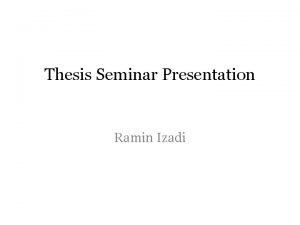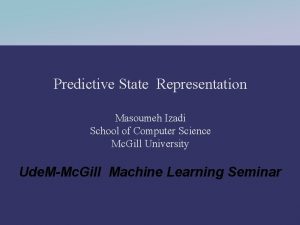Thesis Seminar Presentation Ramin Izadi 1 What is









- Slides: 9

Thesis Seminar Presentation Ramin Izadi

1. What is the question I am interested in? What is the effect of closing down schools on student outcomes?

2. Why would answer to this question be of interest? • The topic has been prominently visible in mainstream media during the 2000 s. • The results would have direct policy implications on school policy in the regional and national level. • No previous empirical studies trying to causally link school close downs and student outcomes.

3. What does economics theory tell about the issue? • Economic theory has little to say about determinants of academic success or health. What about drop out rates? High school entry rates? • Need to go to educational theory? At least an indirect link could be found from theory between student outcomes and variables that are affected by closing down school (class size? ) • The aim of this paper is to determine the causal effect. Theory may help, for example in assessing the credibility of the "selection on observables" assumption.

4. Do I have a convincing strategy of answering the question? The underlying experiment: Random sample of 1000 elementary schools to be closed down out of around 3000 elementary schools nationwide • Control group: The students that would have started first grade in one of the closed schools next year. • Treatment group: Rest of the students who start first grade in an elementary school next year. • Outcome examples: 9 th grade GPA, dropout rate, health outcomes, high school entry rate etc.

Actual identification strategy: Matching: • Control group: Students, whose zip-code indicates that they would have been assigned to start first grade in a closed school. (Students in this group are assigned to a different school instead now. ) • Treatment group: Students, whose schools are not closed down. • Gen. Match to determine the average treatment effect • Is there an implied dif-in-dif design? With staggered entry?

5. Do I have data, or an idea where I could find data for answering the question? • Data comes from Tilastokeskus. My access is through VATT. 6. Is there enough variation in data to identify the effects I am interested in? • Don't know yet

7. Why is there variation in the key independent variables? - In most cases data are not based on controlled experiments • Closed down schools are mostly rural schools. Variation in independent variables arises mainly from the differences between rural and urban students/school environments. • These variations probably correlate heavily with the probability of treatment assignment, which would lead to bias if uncontrolled. • Matching can control for this. • Dif-in-Dif can control for this.

8. What have others written about the issue? How does my approach differ from others? Is there anything I do better than others? • No reference material yet.

















